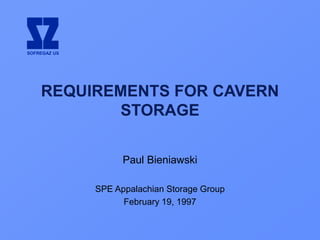970219_SPEAG_Cavern Storage Requirements
- 1. SOFREGAZ US REQUIREMENTS FOR CAVERN STORAGE Paul Bieniawski SPE Appalachian Storage Group February 19, 1997
- 2. SOFREGAZ US OUTLINE • History • Comparisons • Cavern Storage Requirements • Cavern Storage Operations • Effect of Variables • Questions
- 3. SOFREGAZ US HISTORY • 1961 Southeastern Michigan Gas converts abandoned brine caverns in bedded salt to gas storage. • 1963 Saskatchewan Power Corporation commences operations of first caverns designed specifically for gas storage in bedded salt. • 1964 First cavern storage in Armenia. • 1966 First cavern storage in West Germany. • 1968 First cavern storage in France. • 1970 Transcontinental Gas Pipe Line Corporation commences operations of first caverns designed specifically for gas storage in a salt dome. • 1974 First cavern storage in United Kingdom. • 1981 First cavern storage in Denmark.
- 4. SOFREGAZ US COMPARISONS RESERVOIR AQUIFER REEF MINE CAVERN BASE GAS 59% 67% 40% 28% 29% CAPACITY PER WELL 470 785 1,225 165 1,890 DELIVERABILITY PER WELL 3,320 3,395 20,930 10,940 72,715
- 5. SOFREGAZ US REQUIREMENTS • Location • Salt • Caprock • Raw Water • Brine Disposal
- 6. SOFREGAZ US LOCATION • Acreage • Proximity to Pipelines • Proximity to Markets • Proximity to Raw Water Supply • Proximity to Brine Disposal • Proximity to Utilities
- 7. SOFREGAZ US SALT • Salt Purity • Existence and Nature of Caprock • Existence and Nature of Interbeds • Distribution of Interbeds
- 8. SOFREGAZ US ADVANTAGES OF SALT • Impervious to Hydrocarbons • Very High Compressive Strength • Ability to Yield and Divert Stresses • Ability to Flow and Heal Fractures
- 9. SOFREGAZ US LOCATION OF SALT BASINS
- 10. SOFREGAZ US CAPROCK • Not Present in Bedded Salts • Exact Origin Unknown • Believed to be Accumulation of Insolubles Originally Transported in the Salt • Usually Comprised of Anhydrites, Gypsum, and Dolomite • May be Highly Fractured with Numerous Lost Circulation Zones
- 11. SOFREGAZ US RAW WATER • Fresh, Brackish, or Unsaturated Brine • Sources • Aquifers • Rivers • Canals • Lakes • Municipal Supplies
- 12. SOFREGAZ US BRINE DISPOSAL • Wells • Chemical Feedstock • Evaporation Plants • Solar Evaporation • Surface Waters • Displacement
- 16. SOFREGAZ US CAVERN SHAPING Top of Insolubles Raw Water Injection Brine Return Blanket Level Production Casing Brine Return Raw Water Injection SUMP DEVELOPMENT CAVERN DEVELOPMENT
- 17. SOFREGAZ US CAVERN MECHANICS Sump Building Partially Cavern BRINE RETURN INSOLUBLES WATER INJECTION BLANKET LEVEL BRINE RETURN WATER INJECTION BOTTOM OF CAVERN BRINE RETURN BLANKET LEVEL BOTTOM OF CEMENTED CASING BRINE RETURN DEPTH OF ORIGINAL HOLE BLANKET LEVEL INSOLUBLES INSOLUBLES Near Completion Developed Cavern Near Completion WATER INJECTI ON
- 18. SOFREGAZ US CAVERN OPERATIONS. Injection Facilities Withdrawal Facilities Brine Pond GAS EXPANSION BRINE DISPLACEMENT Gas Heater PCR GLYCOL ABSORBER
- 20. SOFREGAZ US EFFECT OF VARIABLES • Minimum Pressure • Maximum Pressure • Insolubles Percentage • Bed Thickness
- 21. SOFREGAZ US MINIMUM PRESSURE GRADIENT 0 0.4 0.8 1.2 1.6 0.1 0.15 0.2 0.25 0.3 Minimum Pressure Gradient, psi/ft BaseGas,Bcf
- 22. SOFREGAZ US MAXIMUM PRESSURE GRADIENT 2.5 2.7 2.9 3.1 3.3 3.5 3.7 0.6 0.65 0.7 0.75 0.8 0.85 0.9 Max Pressure Gradient, psi/ft TotalCapacity,Bcf
- 23. SOFREGAZ US INSOLUBLE CONTENT 0 0.2 0.4 0.6 0.8 1 0 5 10 15 20 25 30 Insoluble Content, % vol CavernVolume,MillionBarrels
- 24. SOFREGAZ US BED THICKNESS 0 0.5 1 1.5 2 2.5 100 150 200 250 300 350 400 Bed Thickness, ft CavernVolume,MillionBarrels

























